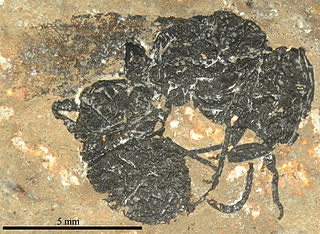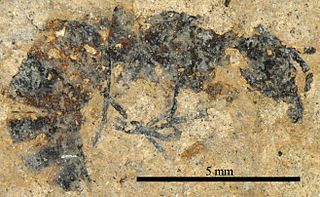
Emplastus is an extinct morphogenus of ants in the subfamily Dolichoderinae, known from fossils found in Asia and Europe. The genus contains twelve species described from sites in England, Eastern Europe and Far Eastern Russia.

Casaleia is an extinct genus of ants in the formicid subfamily Amblyoponinae described by Pagliano & Scaramozzino in 1990 from fossils found in Europe. The genus contains four species dating from the Eocene to Miocene, Casaleia eocenica, Casaleia inversa, Casaleia longiventris, Casaleia orientalis.

Pachycondyla eocenica is an extinct species of ant in the formicid subfamily Ponerinae described from fossils found in Europe. P. eocenica is one of six Lutetian Pachycondyla species.

Pachycondyla lutzi is an extinct species of ant in the formicid subfamily Ponerinae described by from fossils found in Europe. P. lutzi is one of six Lutetian Pachycondyla species.

Pachycondyla? messeliana is an extinct species of ants in the formicid subfamily Ponerinae described by from a fossil found in Europe. P.? messeliana is one of six Lutetian Pachycondyla species.

Pachycondyla parvula is an extinct species of ant in the formicid subfamily Ponerinae described by from a fossil found in Europe. P. parvula is one of six Lutetian Pachycondyla species.

Pachycondyla petiolosa is an extinct species of ant in the formicid subfamily Ponerinae described by from a fossil found in Europe. P. parvula is one of six Lutetian Pachycondyla species.

Pachycondyla petrosa is an extinct species of ant in the formicid subfamily Ponerinae described from a fossil found in Europe. P. petrosa is one of six Lutetian Pachycondyla species.

Paraneuretus is an extinct genus of formicid in the ant subfamily Aneuretinae known from fossils found in Asia and Europe. The genus contains three middle to late Eocene age species, Paraneuretus dubovikoffi, Paraneuretus longicornis, and Paraneuretus tornquisti.
Dolichoderus pinguis is an extinct species of formicid in the ant subfamily Dolichoderinae known from a fossil found in Asia. The species is one of a number in the genus described from fossils.
Liometopum incognitum is an extinct species of formicid in the ant subfamily Dolichoderinae known from fossils found in eastern Asia.
Formica biamoensis is an extinct species of formicid in the ant subfamily Formicinae known from fossils found in eastern Asia.
Formica paleosibirica is an extinct species of formicid in the ant subfamily Formicinae known from fossils found in eastern Asia.
Gesomyrmex macrops is an extinct species of formicid in the ant subfamily Formicinae known from a fossil found in eastern Asia.
Gesomyrmex magnus is an extinct species of formicid in the ant subfamily Formicinae known from a fossil found in eastern Asia.
Gesomyrmex incertus is an extinct species of formicid in the ant subfamily Formicinae known from a fossil found in eastern Asia.
Pachycondyla oligocenica is an extinct species of formicid in the ant subfamily Ponerinae known from a fossil found in eastern Asia.
Pachycondyla aberrans is an extinct species of formicid in the ant subfamily Ponerinae known from a single fossil found in Russia.

Proceratium eocenicum is an extinct species of formicid in the ant subfamily Proceratiinae known from fossils found in the Baltic region.
Agastomyrma is an extinct genus of formicid in the ant subfamily Myrmicinae known from the fossil species Agastomyrma laticeps found in eastern Asia.










